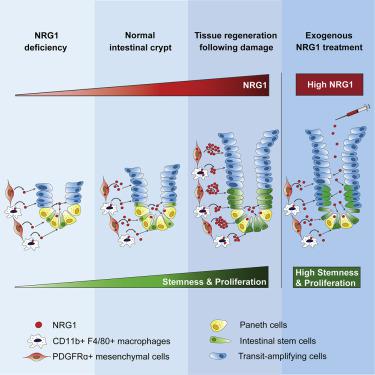Cell Stem Cell ( IF 19.8 ) Pub Date : 2020-07-20 , DOI: 10.1016/j.stem.2020.06.021 Thierry Jardé 1 , Wing Hei Chan 2 , Fernando J Rossello 3 , Tanvir Kaur Kahlon 2 , Mandy Theocharous 4 , Teni Kurian Arackal 2 , Tracey Flores 2 , Mégane Giraud 2 , Elizabeth Richards 2 , Eva Chan 2 , Genevieve Kerr 2 , Rebekah M Engel 5 , Mirsada Prasko 2 , Jacqueline F Donoghue 6 , Shin-Ichi Abe 7 , Toby J Phesse 8 , Christian M Nefzger 9 , Paul J McMurrick 10 , David R Powell 11 , Roger J Daly 4 , Jose M Polo 12 , Helen E Abud 2

|
Epidermal growth factor (EGF) maintains intestinal stem cell (ISC) proliferation and is a key component of organoid growth media yet is dispensable for intestinal homeostasis, suggesting roles for multiple EGF family ligands in ISC function. Here, we identified neuregulin 1 (NRG1) as a key EGF family ligand that drives tissue repair following injury. NRG1, but not EGF, is upregulated upon damage and is expressed in mesenchymal stromal cells, macrophages, and Paneth cells. NRG1 deletion reduces proliferation in intestinal crypts and compromises regeneration capacity. NRG1 robustly stimulates proliferation in crypts and induces budding in organoids, in part through elevated and sustained activation of mitogen-activated protein kinase (MAPK) and AKT. Consistently, NRG1 treatment induces a proliferative gene signature and promotes organoid formation from progenitor cells and enhances regeneration following injury. These data suggest mesenchymal-derived NRG1 is a potent mediator of tissue regeneration and may inform the development of therapies for enhancing intestinal repair after injury.
中文翻译:

间质利基衍生的神经调节蛋白-1驱动肠道干细胞的增殖和受损上皮的再生。
表皮生长因子(EGF)维持肠道干细胞(ISC)的增殖,是类器官生长介质的关键组成部分,但对于肠道动态平衡却是不可或缺的,表明多种EGF家族配体在ISC功能中的作用。在这里,我们确定神经调节蛋白1(NRG1)是关键的EGF家族配体,在损伤后驱动组织修复。NRG1,但不是EGF,在受损时被上调,并在间充质基质细胞,巨噬细胞和Paneth细胞中表达。NRG1删除减少肠道隐窝的增殖并损害再生能力。NRG1强烈刺激隐窝的增生并诱导类器官萌芽,部分原因是通过丝裂原激活的蛋白激酶(MAPK)和AKT的升高和持续激活。一致地,NRG1处理可诱导增殖性基因签名,并促进祖细胞形成类器官,并增强损伤后的再生。这些数据表明,间充质来源的NRG1是组织再生的有效介体,并可能有助于发展损伤后肠道修复的疗法。











































 京公网安备 11010802027423号
京公网安备 11010802027423号